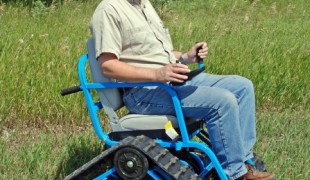- 5901
- 351
- 3
- 1
- 2
- Help Ukraine
About the solution
“It was not the first time my grandmother fell in her home in the United States. But that time, we were all there as we witnessed the fall where she hit her head. She immediately got up and told everyone she was okay. No one paid much attention until in the days that followed when she complained of dizziness. When we brought her to the hospital, the doctors found a blood clot in the brain. That same day she went into a coma and later died. I don’t want this to happen to my other and only remaining grandmother, 92-year-old Alegria San Juan, who happily lives alone in Tagaytay City”, Angelo recalled.
This led him to create SimpleWave, an oval-shaped device that is attached anywhere near the user’s chest. It alerts not only family members but more importantly, the attending doctor who could immediately send an ambulance and if needed, perform a life-saving procedure, in case the user has just suffered a fall, even telling the severity of the impact.
“It functions like those health apps in your smartphones that track steps and movement. But Simple Wave is a lot more sensitive as it detects a fall as a result of an ailment (like fainting due to diabetes or stroke) or due to slips and trips. It could measure the intensity of the fall and automatically send all this information via text and over the Internet to predetermined contacts. The elderly wearer could also talk to the person on the other end since the Simple Wave also incorporates a GSM chipset with micro-SIM, speaker and microphone,” he explained.
This differs from traditional medical alert systems since there’s not a button that needs to be pressed for the alert to go off. After all, once a fall has occurred, the wearer may not be able to manually call for help. So the SimpleWave automatically detects the fall.
Angelo co-founded his company, Simple Wearables, to bring this solution into the market.
Adapted from: https://bit.ly/2YgXEUg
https://bit.ly/2Msm8D6
More info: https://www.simplewearables.com/
https://vimeo.com/129638577
This solution shall not include mention to the use of drugs, chemicals or biologicals (including food); invasive devices; offensive, commercial or inherently dangerous content. This solution was not medically validated. Proceed with caution! If you have any doubts, please consult with a health professional.
DISCLAIMER: This story was written by someone who is not the author of the solution, therefore please be advised that, although it was written with the utmost respect for the innovation and the innovator, there can be some incorrect statements. If you find any errors please contact the patient Innovation team via info@patient-innovation.com
-
-
• Fri, 08/16/2019 - 04:49
Your post is really right and great, a valuable topic. I really like your blog. keep sharing!
street view
-
-
298
-
0
-
4927

Parents create a track-chair for their paralysed son
MOVING IN A WHEELCHAIR: Moving using a wheelchair.
CAREGIVING
Paralysis
Neuromuscular Disorders
Walking Aid (wheelchair/walker/crutches)
Assistive Daily Life Device (to help ADL)
Gait abnormalities (e.g., walking difficulties, unsteady gait)
Difficulty coordinating movements
Stiffness or rigidity (difficulty moving)
Paralysis of the legs and lower body
Muscle weakness
Loss of balance
Promoting inclusivity and social integration
Maintaining Balance and Mobility
Preventing (Vaccination, Protection, Falls, Research/Mapping)
Caregiving Support
Neurology
Neurosurgery
Orthopedics
Rheumatology
United States
-
-
-
230
-
0
-
3531

KeyStrokes – On screen keyboard for disabled people
CAREGIVING
COMMUNICATION: Communicating, whether by speaking, listening, or other means
Social interaction
App (Including when connected with wearable)
Promoting self-management
Promoting inclusivity and social integration
Improving Speech and Communication
Caregiving Support
Medical Genetics
Neurology
Orthopedics
Rheumatology
Mobility issues
Solutions for Disabled people
Netherlands
-
-
-
370
-
0
-
5884

Scooter for disabled people
MOVING IN A WHEELCHAIR: Moving using a wheelchair.
CAREGIVING
Amyotrophic Lateral Sclerosis
Assistive Daily Life Device (to help ADL)
Walking Aid (wheelchair/walker/crutches)
Gait abnormalities (e.g., walking difficulties, unsteady gait)
Muscle cramps or spasms
Difficulty coordinating movements
Stiffness or rigidity (difficulty moving)
Paralysis of the legs and lower body
Muscle weakness
Fatigue
Restoring mobility
Promoting self-management
Rehabilitating After Stroke
Managing Neurological Disorders
Promoting inclusivity and social integration
Preventing (Vaccination, Protection, Falls, Research/Mapping)
Caregiving Support
Neurology
Orthopedics
Rheumatology
United States
-
 en
en
katedaisy • Wed, 08/07/2019 - 11:19
I agree with it, because I understand how difficult it is to go into this issue. driving directions